Gordon Bunshaft
Gordon Bunshaft, FAIA (May 9, 1909 – August 6, 1990), was an American architect, a leading proponent of modern design in the mid-twentieth century. A partner in the architectural firm Skidmore, Owings & Merrill (SOM), Bunshaft joined in 1937 and remained for more than 40 years. The long list of his notable buildings includes Lever House in New York, the Beinecke Rare Book and Manuscript Library at Yale University, the Hirshhorn Museum and Sculpture Garden in Washington, D.C., the National Commercial Bank in Jeddah, Saudi Arabia, 140 Broadway (Marine Midland Grace Trust Co.) and Manufacturers Hanover Trust Branch Bank in New York; the last was the first post-war "transparent" bank on the East Coast.[1]
Gordon Bunshaft | |
|---|---|
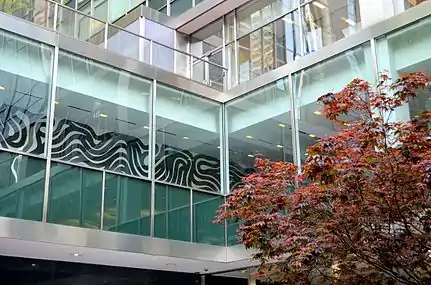 Lever House, 1951-1952; Gordon Bunshaft at Skidmore, Owings, and Merrill. Sol LeWitt, Wall Drawing 999. | |
| Born | May 9, 1909 |
| Died | August 6, 1990 (aged 81) |
| Nationality | American |
| Alma mater | Lafayette High School Massachusetts Institute of Technology |
| Occupation | Architect |
| Spouse(s) | Nina Wayler
(m. 1943; |
| Awards | American Institute of Architects Twenty-five Year Award, elected to the National Institute of Arts and Letters, Pritzker Architecture Prize |
| Practice | Skidmore, Owings & Merrill |
| Buildings | Lever House, Beinecke Rare Book and Manuscript Library, Hirshhorn Museum and Sculpture Garden |
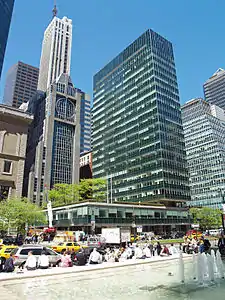
Early life
Bunshaft was born in Buffalo, New York, to Russian Jewish immigrant parents,[2] and attended Lafayette High School. He received both his undergraduate (1933) and his master's (1935) degrees from the Massachusetts Institute of Technology, studied in Europe on a Rotch Traveling Scholarship from 1935 to 1937.
Career
After his traveling scholarship, Bunshaft worked briefly for Edward Durell Stone and industrial designer Raymond Loewy before joining SOM. Bunshaft's early influences included Mies van der Rohe and Le Corbusier.[3]
In the 1950s, Bunshaft was hired by the State Department's Office of Foreign Building Operations as a collaborator on the design for several U.S. consulates in Germany.[4][5]
Bunshaft's only single-family residence was the 2300 square foot (210 m²) Travertine House, built for his own family. On his death he left the house to MoMA, which sold it to Martha Stewart in 1995.[6] Her extensive remodelling stalled amid an acrimonious planning dispute with a neighbour. In 2005, she sold the house to textile magnate Donald Maharam, who described the house as "decrepit and largely beyond repair" and demolished it.[7][8][9]
Awards and honors
Bunshaft was elected to the National Institute of Arts and Letters and was the recipient of numerous other honors and awards. He received the Brunner Prize of the American Academy and Institute of Arts and Letters in 1955, and its gold medal in 1984. He also received the American Institute of Architects Twenty-five Year Award for Lever House, in 1980, and the Pritzker Architecture Prize, in 1988. In 1958, he was elected into the National Academy of Design as an Associate member, and became a full member in 1959. From 1963 to 1972, he was a member of the Commission of Fine Arts in Washington.[1]
Upon receiving the Pritzker Prize in 1988,[10] for which he nominated himself,[11] he gave the shortest speech of any winner in the award's history, stating:
In 1928, I entered the MIT School of Architecture and started my architectural trip. Today, 60 years later, I've been given the Pritzker Architecture Prize for which I thank the Pritzker family and the distinguished members of the selection committee for honoring me with this prestigious award. It is the capstone of my life in architecture. That's it.
Bunshaft was a trustee of the Museum of Modern Art. He also received the Medal of Honor of the New York Chapter of the American Institute of Architects.[1]
Legacy
Bunshaft's personal papers are held by the Department of Drawings & Archives in the Avery Architectural and Fine Arts Library at Columbia University; his architectural drawings remain with SOM.
Buildings
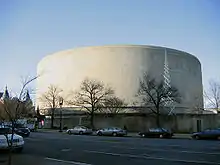

- 1942 – Great Lakes Naval Training Center, Hostess House – Great Lakes, Illinois
- 1951 – Lever House – New York, New York
- 1952 – Manhattan House – New York, New York
- 1953 – Manufacturers Trust Company Building – New York, New York[12]
- 1956 – Ford World Headquarters – Dearborn, Michigan, with Natalie de Blois
- 1956 – Consular Agency of the United States, Bremen – Bremen, Germany[13]
- 1957 – Connecticut General Life Insurance Company Headquarters – Bloomfield, Connecticut[14]
- 1955 – Istanbul Hilton – Istanbul, Turkey
- 1958 – Reynolds Metals Company International Headquarters – Richmond, Virginia[15]
- 1961 – 28 Liberty Street – New York, New York
- 1962 – CIL House – Montreal, Quebec
- 1962 – Albright-Knox Art Gallery addition – Buffalo, New York
- 1963 – Travertine House – East Hampton, New York
- 1963 – Beinecke Library – Yale University, New Haven, Connecticut
- 1965 – American Republic Insurance Company Headquarters – Des Moines, Iowa
- 1965 – Banque Lambert – Brussels, Belgium
- 1965 – New York Public Library for the Performing Arts (interiors) – New York, New York
- 1965 – Hayes Park Central & South Buildings – Hayes, United Kingdom [16]
- 1965 – Warren P. McGuirk Alumni Stadium – University of Massachusetts, Amherst, Massachusetts
- 1967 – 140 Broadway – New York City
- 1971 – Lyndon Baines Johnson Library and Museum – Austin, Texas
- 1972 – Carlton Centre – Johannesburg, South Africa
- 1973 – New York City Convention and Exhibition Center (not built) – New York, New York[17]
- 1973 – Uris Hall, Cornell University – Ithaca, New York
- 1974 – Solow Building – 9 West 57th Street, New York, New York
- 1974 – W. R. Grace Building – New York, New York
- 1974 – Hirshhorn Museum and Sculpture Garden – Washington, D.C.
- 1983 – National Commercial Bank – Jeddah, Saudi Arabia
Gallery
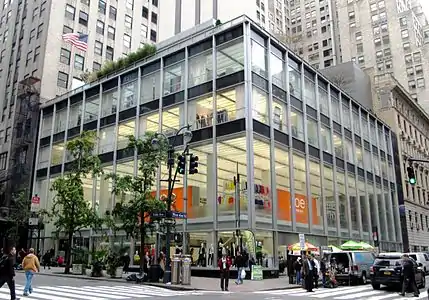 Manufacturers Trust Building
Manufacturers Trust Building
New York, New York 1954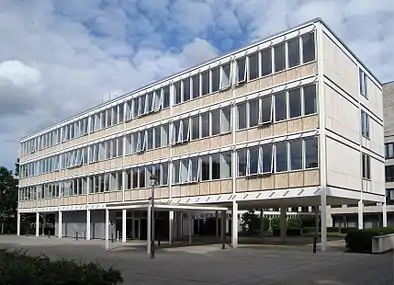 United States Consular Agency
United States Consular Agency
Bremen, Germany 1956 Ford World Headquarters
Ford World Headquarters
Dearborn, Michigan 1956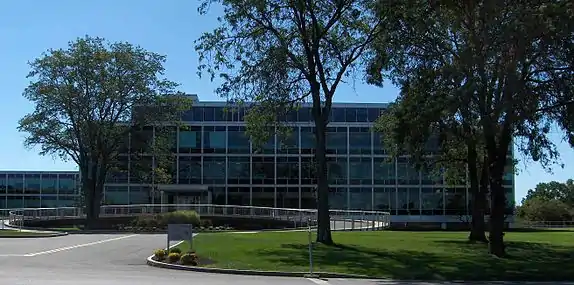 Connecticut General Life Insurance Headquarters
Connecticut General Life Insurance Headquarters
Bloomfield, CT 1957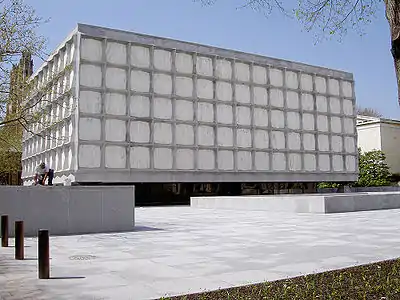 Beinecke Library
Beinecke Library
Yale University, New Haven, CT 1963.jpg.webp) Beinecke Library Interior
Beinecke Library Interior
Yale University, New Haven, CT 1963 Johnson Presidential Library
Johnson Presidential Library
Austin, Texas, 1971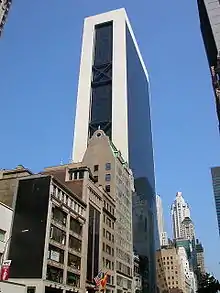 Solow Building
Solow Building
New York, 1974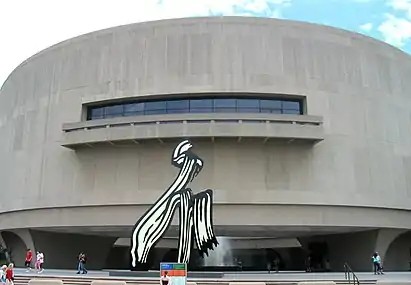 Hirshhorn Museum
Hirshhorn Museum
Washington, D.C. 1974
Personal life
In 1943, Bunshaft married Nina Wayler (d. 1994). They were avid collectors of contemporary art and owned many major pieces including works by Joan Miró, Dubuffet, Giacometti, Léger and Noguchi.[1] They lived in the Manhattan House Apartments in New York's Upper East Side, which he helped design, and at the Travertine House in East Hampton, which was his only single-family residence.[6]
He is buried next to his wife and parents in the Temple Beth El cemetery on Pine Ridge Road in Buffalo, New York.
References
- Goldberger, Paul (8 August 1990). "Gordon Bunshaft, Architect, Dies at 81". The New York Times. Retrieved 30 March 2017.
- Vanity Fair: "Forever Modern" October 2002
- Thomas E. Luebke, ed., Civic Art: A Centennial History of the U.S. Commission of Fine Arts (Washington, D.C.: U.S. Commission of Fine Arts, 2013): Appendix B, p. 541.
- Goldberger, Paul (19 August 1990). "ARCHITECTURE VIEW; Gordon Bunshaft: A Man Who Died Before His Time?". The New York Times. Retrieved 30 March 2017.
- Times, Special To The New York (17 November 1958). "ARTS CENTER PICKS LAST 2 ARCHITECTS; Saarinen and Bunshaft Will Round Out Design Team for Lincoln Sq. Project WORKS RECEIVE PRAISE Group Will Be Coordinated by Wallace K. Harrison -'Dynamic' Result Sought". The New York Times. Retrieved 30 March 2017.
- Brown, Patricia Leigh (23 February 1995). "Can It Be True? Is Martha Stewart Really Going Modern?". The New York Times. Retrieved 30 March 2017.
- Martha's Gordon Bunshaft House Gets the Shaft - Hollywood's Fear of Flying - Warner Music Gets Murder Inc. - Ivy League Beauty Pageants - Bill Weld's Uphill Battle for Albany Archived 2006-07-02 at the Wayback Machine. Newyorkmetro.com (2005-05-23). Retrieved on 2014-04-12.
- Archived April 11, 2006, at the Wayback Machine
- Monchaux, Thomas De (3 July 2005). "Modernist Masterpiece, and Soon a Prime Building Site". The New York Times. Retrieved 30 March 2017.
- Goldberger, Paul (24 May 1988). "Bunshaft and Niemeyer Share Architecture Prize". The New York Times. Retrieved 30 March 2017.
- How to win the Pritzker Architecture Prize: Practice, practice, practice (and don't be shy about nominating yourself)
- Pogrebin, Robin (April 13, 2011). "New York Landmarks Panel Wants Changes in Plan for Former Bank". The New York Times. Retrieved March 30, 2017.
- "Public Works: Harry Bertoia for the Public". Harry Bertoia. Archived from the original on March 10, 2015. Retrieved March 1, 2015.
- "Fans of Modernism Criticize Cigna's Plan to Raze Offices". The New York Times. February 22, 2001. Retrieved March 30, 2017.
- Pristin, Terry (November 26, 2003). "Philip Morris USA Starts Its Move to a Historic Building". The New York Times. Retrieved March 30, 2017.
- https://historicengland.org.uk/listing/the-list/list-entry/1242724
- Darnton, John (February 14, 1973). "Convention Center Model Unveiled Here With Pride". The New York Times. ISSN 0362-4331. Retrieved June 9, 2020.
Further reading
- Carol Herselle Krinsky, Gordon Bunshaft of Skidmore, Owings & Merrill, MIT Press, 1988
External links
| Wikimedia Commons has media related to Gordon Bunshaft. |
- "Oral history interview with Gordon Bunshaft". Chicago Architects Oral History Project, The Art Institute of Chicago. Archived from the original on May 16, 2006. Retrieved October 13, 2005.
- "Wrecking Ball". MetaFilter. Retrieved October 12, 2005. Discussion and links about preservation and rebuilding of the Bunshaft Residence, aka "Travertine House.".
- "Gordon Bunshaft 1988 Laureate". The Pritzker Architecture Prize. Archived from the original on December 10, 2008. Retrieved October 12, 2005.
- Gordon Bunshaft architectural drawings and papers, 1909-1990 (bulk 1950-1979). Held by the Department of Drawings & Archives, Avery Architectural & Fine Arts Library, Columbia University.
- Gordon Bunshaft at Find a Grave